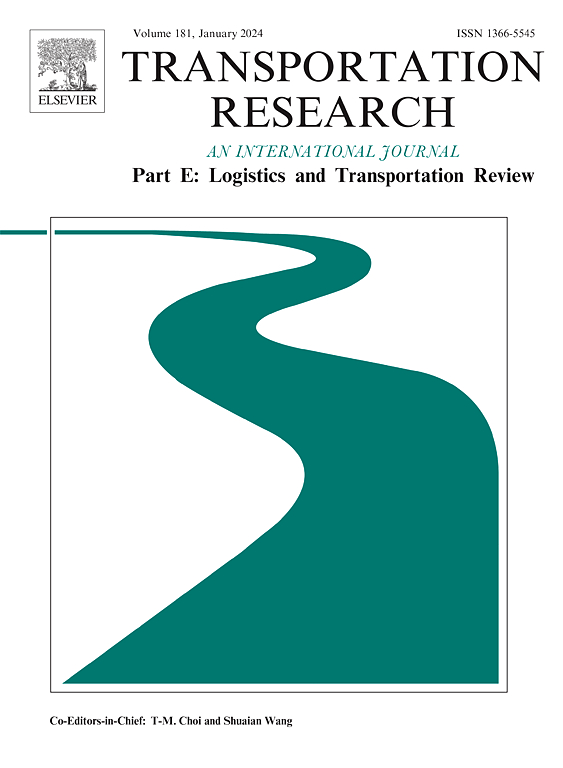多重运输方式、全网时间相互依赖的双层集装箱运输
IF 8.8
1区 工程技术
Q1 ECONOMICS
Transportation Research Part E-Logistics and Transportation Review
Pub Date : 2025-10-01
DOI:10.1016/j.tre.2025.104436
引用次数: 0
摘要
本文研究了一个包含多种运输方式的双层集装箱拖运问题,并试图探索其潜在的应用优势。该问题集中于货车运输,是经典的两梯队车辆路径问题的一种变体。在第一梯队,一队拖拉机,通常使用长组合车辆,在中央仓库和多个卫星之间运输拖车。在第二梯队,由于运输法规的限制,拖拉机车队只能使用单拖车停留模式,在卫星和客户之间进行多趟拖车运输。该牵引车可执行两种操作,即放下和拉起拖车(即涉及同时交付和收集集装箱)。这些特点使得两个梯队的路线紧密耦合,导致整个网络内时间相互依赖交织在一起。建立了求解这种具有时间依赖性的两梯队调度的数学公式。为了提高计算效率,给出了两组有效不等式。将所提出的数学模型与启发式技术相结合,提出了一种两阶段数学算法。引入了一种结合固定和释放机制的路由串调度框架,以减轻网络时间依赖特性带来的复杂性。该算法比可比的(元)启发式算法拥有更少的参数,提供了一个实际的实现。数学模型,以及有效的不等式和数学算法的性能,通过计算实验验证了从先前的研究中建立的实例。此外,还进行了实验,以调查客户分配模式和最大允许拖车数量对操作效率的影响。本文章由计算机程序翻译,如有差异,请以英文原文为准。
Two-echelon container drayage with multiple transportation modes and overall-network time interdependence
This study addresses a two-echelon container drayage problem incorporating multiple transportation modes, and attempts to explore its potential application advantages. The problem concentrates on truckload transportation, and represents a variation of the classical two-echelon capacity-constrained vehicle routing problem. In the first echelon, a fleet of tractors, often employing long combination vehicles, transports trailers between a central depot and multiple satellites. In the second echelon, a fleet of tractors, restricted to a single-trailer stay-with mode, due to transportation regulations, executes multi-trip trailer transportation between satellites and customers. The tractor can perform two operations of dropping-off and pulling-up trailers (i.e., simultaneous delivery and collection of containers are involved). These characteristics make the routes of the two echelons couple tightly, and result in intertwined time interdependence within the entire network. A mathematical formulation is developed to address this two-echelon scheduling with time interdependence. To enhance computational efficiency, two groups of valid inequalities are provided. A two-stage matheuristic algorithm integrating the proposed mathematical model and heuristic techniques is developed. A route-string scheduling framework combined with a fixing and releasing mechanism is introduced to mitigate the complexity associated with the time-interdependence nature of the network. This algorithm, possessing fewer parameters than comparable (meta-) heuristics, offers a practical implementation. The mathematical model, along with the valid inequalities and the performance of the matheuristic algorithm, are validated through computational experiments using established instances from prior studies. Furthermore, experiments are undertaken to investigate the effects of customer distribution patterns and maximum permissible trailers count on operational efficiency.
求助全文
通过发布文献求助,成功后即可免费获取论文全文。
去求助
来源期刊
CiteScore
16.20
自引率
16.00%
发文量
285
审稿时长
62 days
期刊介绍:
Transportation Research Part E: Logistics and Transportation Review is a reputable journal that publishes high-quality articles covering a wide range of topics in the field of logistics and transportation research. The journal welcomes submissions on various subjects, including transport economics, transport infrastructure and investment appraisal, evaluation of public policies related to transportation, empirical and analytical studies of logistics management practices and performance, logistics and operations models, and logistics and supply chain management.
Part E aims to provide informative and well-researched articles that contribute to the understanding and advancement of the field. The content of the journal is complementary to other prestigious journals in transportation research, such as Transportation Research Part A: Policy and Practice, Part B: Methodological, Part C: Emerging Technologies, Part D: Transport and Environment, and Part F: Traffic Psychology and Behaviour. Together, these journals form a comprehensive and cohesive reference for current research in transportation science.

 求助内容:
求助内容: 应助结果提醒方式:
应助结果提醒方式:


